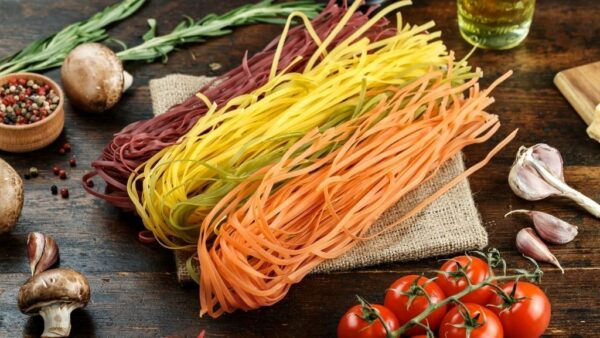Colours have strong purchase incentive effects, so we tend to grab the soft drink from the shelf that has the brightest colour. However, this colour usually doesn’t come from the fruits and vegetables in the product, but from food colourants. It is important to try to limit the use of products that contain artificial additives in order to avoid consuming them in excess and possible cross-reactions.
You can learn everything about natural food colourants from this article:
- Colourant as an additive
- Types of colourants
- Natural food colourants and colourants of natural origin
Colourant as an additive
Food additives cannot be used as a food product on their own, they only improve the flavour, colour, shelf-life and aid in the processing and manufacture. Additives originally were divided into four main groups (colourants, texturing agents, preservatives, and antioxidants), but their number has increased significantly since then. Food additives have E numbers, colourants are from E100 to E200. Lower numbers refer to lighter colours and higher numbers indicate darker ones. Colourants are important because natural colour content is reduced during production. Most colourants are sensitive to oxygen, and heat changes the colour of the raw material, but consumers want to see the natural colour when they purchase a packaged product. Of course, some manufacturers go over the top and the goal is not to restore the original colour, but to create a truly eye-catching product.
Types of colourants
Colourants can be natural, of natural origin or artificial. Natural colourants are obtained from food raw materials (e.g. carotenoids, anthocyanins, red beetroot). Natural colourants are usually of plant origin and provide the natural vibrant colour of plants (e.g. carotenoids – carrots). In addition to the colouring effect, these have favourable nutritional value, but their disadvantage is that they are quite expensive, not stable enough as compounds and they sometimes keep the natural flavour of the plant. Colourants of natural origin are derived from natural, plant or animal materials, but not by extraction (e.g. caramel, activated carbon), as they do not occur naturally in this form.
Artificial dyes don’t occur in nature, are produced synthetically, and have a different chemical structure from natural materials. The need for artificial dyes came from the fact that they were cheaper and more stable than natural colourants, but in some cases, they could cause an allergic reaction. Dyes are mainly used in desserts, puddings, yoghurts, soft drinks, syrups and spirits. The E number on the food label doesn’t indicate whether the product contains natural or artificial colourants.
Natural food colourants and colourants of natural origin
In nature, the wonderful colours of plants have important biological functions. When we buy juice, we want to see the original colour of the fruit, even when it is a drink with a 20% fruit content that has been pressed and diluted until it no longer resembles its original state. If at least the colour is right, we can think that the drink contains the fruit itself and thus it has all its health-promoting properties of it.
However, in many cases, when the manufacturing process is not so aggressive, the product does in fact have all the health-promoting properties of the fruit in addition to its natural colour (e.g. antioxidant properties).
So let’s take a look at the natural colourants we can find in the products we buy from the stores.
Curcumin (E100)
Curcumin is extracted from turmeric, which we otherwise use as a herb, and it gives a yellow, orange colour. It is cheaper than saffron that has a similar colour, but it has poorer colour fastness. It can also be obtained by extraction or fermentation. Curcumin makes margarine, jam, potato flakes yellower, but it is also used in non-alcoholic beverages and cold cuts. Curcumin is mostly harmless, very rarely causing allergic reactions.
Riboflavin (E101)
Riboflavin is also known as vitamin B2. It is found in meat, milk, eggs, yeast, green vegetables, and whole wheat bread. It is yellow in colour, extracted from whey or yeast, but can also be produced synthetically. Riboflavin is often used to colour creams, sweets, ice creams, mayonnaise, pastas, soft drinks, and wines. It is completely harmless. It can be used without any quantitative restriction, so sometimes it is not only used for colouring but to increase the vitamin content of a product.
Carotenes or carotenoids (E160)
Carotenoids are natural fat-soluble compounds. They have a yellow, orange, or red colour. Carotene is most commonly found in carrots, sweet potatoes, pumpkins, apricots, spinach, tomatoes, red peppers, and even some algae. When carotene is used as a colourant, it remains stable when combined with ascorbic acid. It has a lot of positive physiological effects. Carotene has an antioxidant effect and plays a major role in the production of vitamin A, and also enhances vision. It is a non-toxic additive, but if consumed in large quantities, it produces an orange-brown colour in the skin. Carotene can be found as a colourant in butter, margarine, cheese, mayonnaise, ice creams, desserts, and even sausages.
Anthocyanins (E163)
Anthocyanins give the blue, red, and purple colours of flowers and fruits. They can be found in grapes, elderberries, raspberries, red cabbage, and cherries, but also in bananas and pears. They are water-soluble and have antioxidant properties similar to carotene. Anthocyanins produce different colours at different pH values, so they are red in acidic conditions and blue in alkaline solutions. Anthocyanins are obtained by extraction mainly from the skin of black grapes and black corn. They are harmless and can be used without restrictions. It can be found in cereals, jams, jellies, and beverages, but also in cosmetic products and some medicines.
Chlorophyll (E140)
Chlorophyll is the natural green colour of plants. It is soluble in fat and exhibits only fair stability to heat and acids. We found it in all green plants, but it is mostly extracted from nettle and alfalfa. It can be used without restrictions in food products. Chlorophyll is most commonly used as a colourant in sweets, chewing gums, certain types of cheese, marinades, jams and liqueurs.
Betanin (E162)
Betanin is also known as Beetroot Red, which says everything about it. It is red in colour, obtained from beets by pressing or by aqueous extraction. It is soluble in water; however, it exhibits only fair stability to heat and light. In some cases, it is not betanin (i.e. not a colourant) is used to colour the food, but beet juice concentrate. Often betanin gives the red or reddish colour to cereals, ice creams, yoghurts, desserts, chewing gums, soups, sauces, pies and sausages. It can be used without any restriction, even in medicines and cosmetic products.
Food colourants from the mineral origin(E170-175)
Food colourants of natural origin cannot only be derived from animals or plants but minerals too. These include calcium carbonates, iron oxide, titanium dioxide, and gold and silver. While it is surprising at first and perhaps seems a little frightening that our food may contain such materials, they carry low risk due to their insolubility and poor rate of absorption. They are primarily used to colour desserts, sweets and jellybeans.
Carmine (E120)
Lastly, we have the least attractive dye of natural origin, carmine, which is produced from cochineal insects. It is made from the raw dried and pulverised bodies of female insects. The process produces carminic acid, which colours the food bright red. Since this colourant is of animal origin, vegetarians and vegans avoid it. It cannot be used in every food product. We found it mostly in yoghurts, sweets, jams, edible coatings and fruit wines. It may cause an allergic reaction in those sensitive to it, especially respiratory or skin symptoms.
For example, if you have concerns about a product that contains the E162 additive, keep in mind that it’s made from beetroots. However, let’s not forget that these colourants don’t really do much for the product except for giving it some colour, so if we can, eat colourful fruits and vegetables in their original form instead.


